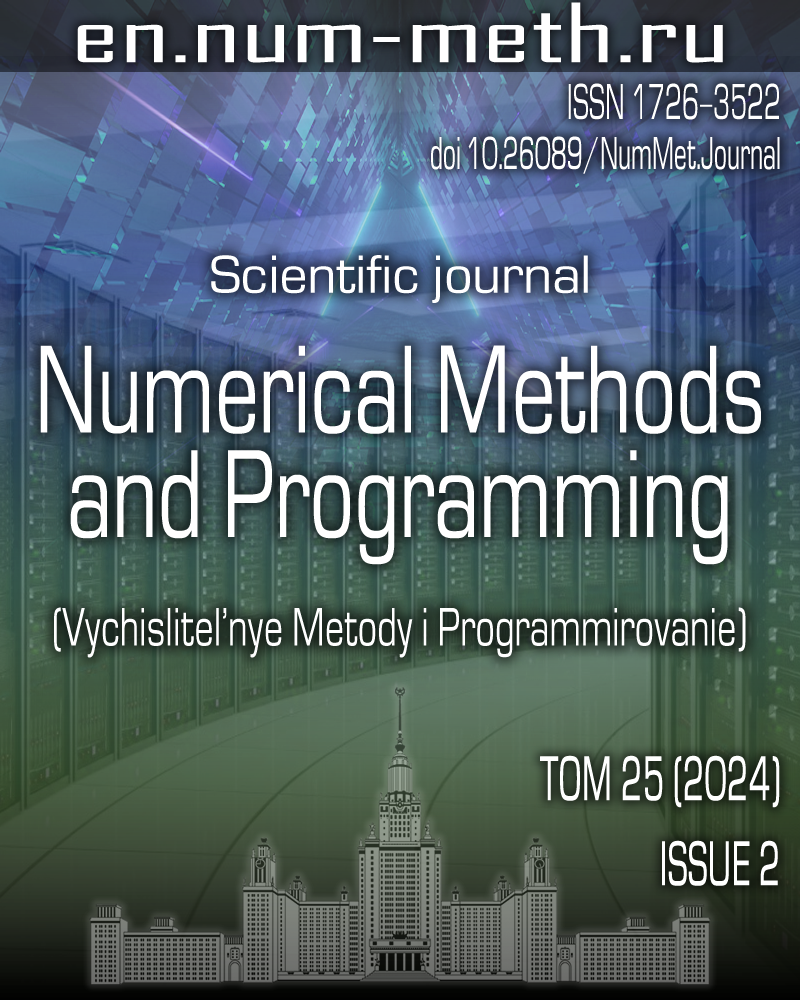DOI: https://doi.org/10.26089/NumMet.v25r216
Program package for two-dimensional modeling offluidodynamic processes in hydrate-containing environment of sedimentary basins
Keywords:
Abstract
Currently, the investigation of gas hydrate deposits is very relevant. The study of sedimentary basins containing gas hydrates is complicated by the presence of complex geometric regions in them (interlayers, shear and low-permeability zones, etc.). Areal and profile calculations have spatial stratigraphic unstructured areas, their arbitrary location and variable effective thickness of layers. This work focuses on the study of the problem of two-dimensional filtration in a zone of three-phase hydrate equilibrium (gas, hydrate, water), taking into account the possible low permeability of rocks. To solve this problem, an original filtration model with a non-classical form of the law of motion is used. Based on the support operator method, the effective computational algorithms that distinguish the hyperbolic (for the transfer of water and hydrate saturation) and piezoconductive-dissipative parts of the problem have been developed. Their program implementation on grids of irregular structure, which make it possible to model the processes of dissociation of gas hydrates in sedimentary basins of complex geometric and lithological structure were realized. Numerical calculations for a model domain with parameters corresponding to a real sedimentary basin in the South China Sea were realized.
Published
Issue
Section
References
- V. T. Gudzenko, A. A. Varenichev, and M. P. Gromova, “Gas Hydrates. Information and Analytical Review,” Geology, Geophysics and Development of Oil and Gas Fields. No. 5, 39-68 (2016) [in Russian].
- T. V. Matveeva, Formation of Hydrocarbon Gas Hydrates in Subaquatic Environments. in World Ocean , Vol. 3: Solid Minerals and Gas Hydrates in the Ocean (Nauchnyi Mir, Moscow, 2018), pp. 586-697 [in Russian].
- Z. R. Chong, S. H. B. Yang, P. Babu, et al., “Review of Natural Gas Hydrates as an Energy Resource: Prospects and Challenges,” App. Energy 162, 1633-1652 (2016).
doi 10.1016/j.apenergy.2014.12.061 - X.-Q. Pang, C.-Z. Jia, Z.-X. Chen, et al., “Reduction of Global Natural Gas Hydrate (NGH) Resource Estimation and Implications for the NGH Development in the South China Sea,” Pet. Sci. 19 (1), 3-12 (2022).
doi 10.1016/j.petsci.2021.12.006 - S. Sh. Byk, Yu. F. Makogon, and V. I. Fomina, Gas Hydrates (Khimiya, Moscow, 1980) [in Russian].
- K. S. Basniev, I. N. Kochina, and V. M. Maksimov, Underground Hydromechanics (Nedra, Moscow, 1993) [in Russian].
- O. Ju. Poveschenko, I. V. Gasilova, I. I. Galiguzova, et al., “A Fluid Dynamics Model for a Porous Media, Containing Gas Hydrate Deposits,” Mat. Model. 25 (10), 32-42 (2013).
- Yu. Poveshchenko, P. Rahimly, O. Rahimly, et al., “A Numerical Approach to Study the Thermal Influence on Gas Hydrates by Physical Process Splitting,” Int. J. Numer. Anal. Model. 17 (3), 404-433 (2020).
- N. Alekseeva, V. Podryga, P. Rahimly, et al., “Mathematical Modeling of Gas Hydrates Dissociation in Porous Media with Water-Ice Phase Transformations Using Differential Constrains,” Mathematics. 10 (19), 3470-3489 (2022).
doi 10.3390/math10193470 - P. I. Rahimly, Yu. A. Poveshchenko, O. R. Rahimly, et al., “The Use of Splitting with Respect to Physical Processes for Modeling the Dissociation of Gas Hydrates,” Mat. Model. 29 (7), 133-144 (2017) [Math. Models Comput. Simul. 10 (1), 69-78 (2018)].
doi 10.1134/S2070048218010118 - A. E. Bakeer, Yu. A. Poveshchenko, V. O. Podryga, and P. I. Rahimly, Spatial Filtration Model of Hydrate-containing Media with a Non-classical Law of Motion , Preprint No. 10 (Keldysh Institute of Applied Mathematics, Moscow, 2024) [in Russian].
https://keldysh.ru/papers/2024/prep2024_10.pdf . Cited May 1, 2024.
doi 10.20948/prepr-2024-10 - A. E. Bakeer, Yu. A. Poveshchenko, V. O. Podryga, and P. I. Rahimly, “About One Spatial Filtration Model with a Non-classical Law of Motion in a Hydrate-containing Medium,” Mat. Model. 36 (2), 77-98 (2024).
doi 10.20948/mm-2024-02-05 - A. A. Samarskii, V. F. Tishkin, A. P. Favorsky, and M. Yu. Shashkov, “Use of the Support Operator Method for Constructing Difference Analogues of Operations of Tensor Analysis,” Differ. Uravn. 18 (7), 1251-1256 (1982).
- K. Lipnikov, G. Manzini, and M. Shashkov, “Mimetic Finite Difference Method,” J. Comput. Phys. 257, Part B, 1163-1227 (2014).
doi 10.1016/j.jcp.2013.07.031 - A. A. Samarskii, A. V. Koldoba, Yu. A. Poveshchenko, et al., Difference Schemes on Irregular Grids (Kriterii, Minsk, 1996) [in Russian].
- J.-L. Ye, X.-W. Qin, W.-W. Xie, et al., “The Second Natural Gas Hydrate Production Test in the South China Sea,” China Geol. 3 (2), 197-209 (2020).
doi 10.31035/cg2020043 - X. Ma, Y. Sun, B. Liu, et al., “Numerical Study of Depressurization and Hot Water Injection for Gas Hydrate Production in China’s First Offshore Test Site,” J. Nat. Gas Sci. Eng. 83, Article ID 103530 (2020).
doi 10.1016/j.jngse.2020.103530 - H. Su, D. Wang, P. Zhang, et al., “A New Method to Calculate the Relative Permeability of Oil and Water in Tight Oil Reservoirs by Considering the Nonlinear Flow,” Geofluids. 2022, Article ID 9450967 (2022).
doi 10.1155/2022/9450967 - E. A. Bondarev, G. D. Babe, A. G. Groysman, and M. A. Kanibolotskiy, Mechanics of Hydrate Formation in Gas Flows (Nauka, Novosibirsk, 1976) [in Russian].
- K. Aziz and A. Settari, Petroleum Reservoir Simulation (Applied Science Publ., London, 1979; Inst. Komp’yut. Issled., Moscow-Izhevsk, 2004).
- L. A. Hageman and D. M. Young, Applied Iterative Methods (Academic Press, New York, 1981; Mir, Moscow, 1986).
- A. Buluç, J. T. Fineman, M. Frigo, et al., “Parallel Sparse Matrix-Vector and Matrix-Transpose-Vector Multiplication Using Compressed Sparse Blocks,” in Proc. 21st Annual ACM Symposium on Parallelism in Algorithms and Architectures, Calgary, Canada, August 11, 2009.
https://api.semanticscholar.org/CorpusID: 2762299Cited May 1, 2024. - Y. Saad, Iterative Methods for Sparse Linear Systems (SIAM, Philadelphia, 2003; Mosk. Gos. Univ., Moscow, 2013).
doi 10.1137/1.9780898718003 - A. I. Gritsenko, Z. S. Aliev, O. M. Ermilov, et al., Well Testing Guide (Nauka, Moscow, 1995) [in Russian].
License
Copyright (c) 2024 А. Э. Бакир

This work is licensed under a Creative Commons Attribution 4.0 International License.


